Integration of Waste to Bioenergy Conversion Systems: A Critical Review
Abstract
:1. Introduction
2. Biomass Waste
2.1. Lignocellulosic Biomass Waste
2.2. Organic Solid Waste
2.3. Liquid Biomass Waste
3. Waste to Energy Conversion Processes
3.1. Thermochemical Methods
3.2. Biochemical Methods
3.2.1. Solid Organic Waste Conversion
3.2.2. Liquid Waste Conversion
- Anaerobic Digestion: Anaerobic digestion of wastewater entails the breakdown of organic matter in wastewater in the absence of oxygen, resulting in the production of biogas, carbon dioxide, and treated water as products [57]. Aside from the products, wastewater treatment using anaerobic digestion (AD) reduces pollutant levels, stabilizes sludge, and reduces sludge tonnage significantly with minimal energy input [49]. Traditional anaerobic digestion has long been used to breakdown organic compounds and pathogens in wastewater collected in ponds [59]. Because conventional AD methods necessitate a long retention period and large treatment areas, more advanced anaerobic reactors, such as the Upflow anaerobic sludge blanket reactor (UASB), with short contact time between bacteria and wastewater, have been developed [59,60]. Even though Upflow anaerobic sludge blanket (UASB) reactors have the potential to significantly increase biogas yield [61], the technology still requires further development to overcome foaming and other AD inhibitions, particularly at high organic loading rates (OLR) [52].
- Bioelectrochemical systems (BECS): Bioelectrochemical conversion has emerged as one of the most efficient ways to cleanse wastewater and produce bioenergy (bioelectricity and hydrogen) [70]. Microbial fuel cells (MFCs) and microbial electrochemical cells (MECs) are two types of bioelectrochemical cells in which one of the electrodes interacts with microorganisms (usually anode respiring bacteria, ARB) to transfer electrons from the organic substrate to the electrode [71,72]. While MFCs require the presence of an oxidative agent (i.e., oxygen) to generate electricity, MECs require a modest amount of energy from an external source to fuel the redox reactions that produce hydrogen gas [68]. MFC’s ability to generate energy from wastewater makes it more eco-friendly; however, the technology is still in its early stages, and the electricity generated is insufficient for large-scale application [65,66]. Studies show that MECs offer the substantial potential to improve the efficiency of liquid waste biorefineries; nevertheless, the process is economically unfavorable due to the high capital costs of technology adoption [69]. Furthermore, obstacles such as ohmic and concentration losses, saturation kinetics, and competing reactions like methanogenesis, which reduce the rate of hydrogen production, continue to stymie MEC technology’s commercialization [67].
- Microalgal Cultivation: The process of algae cultivation requires carbon dioxide and light energy, organic and inorganic carbon, as well as inorganic nitrogen (N) and phosphorous (P), present in wastewater [73]. Because algae biomass is unicellular and buoyant, structurally complex substances such as lignin and hemicellulose are not required for growth [74]. For this reason, microalgae are most desirable biofuel source because the cell walls are not resistant to treatment conditions, necessitating just moderate pretreatments [75]. Microalgae contain valuable components like proteins, carbohydrates, and lipids that can be converted into biofuels such as alcohols, biogas, and biodiesel through a number of conversion routes [76], as shown in Figure 5.
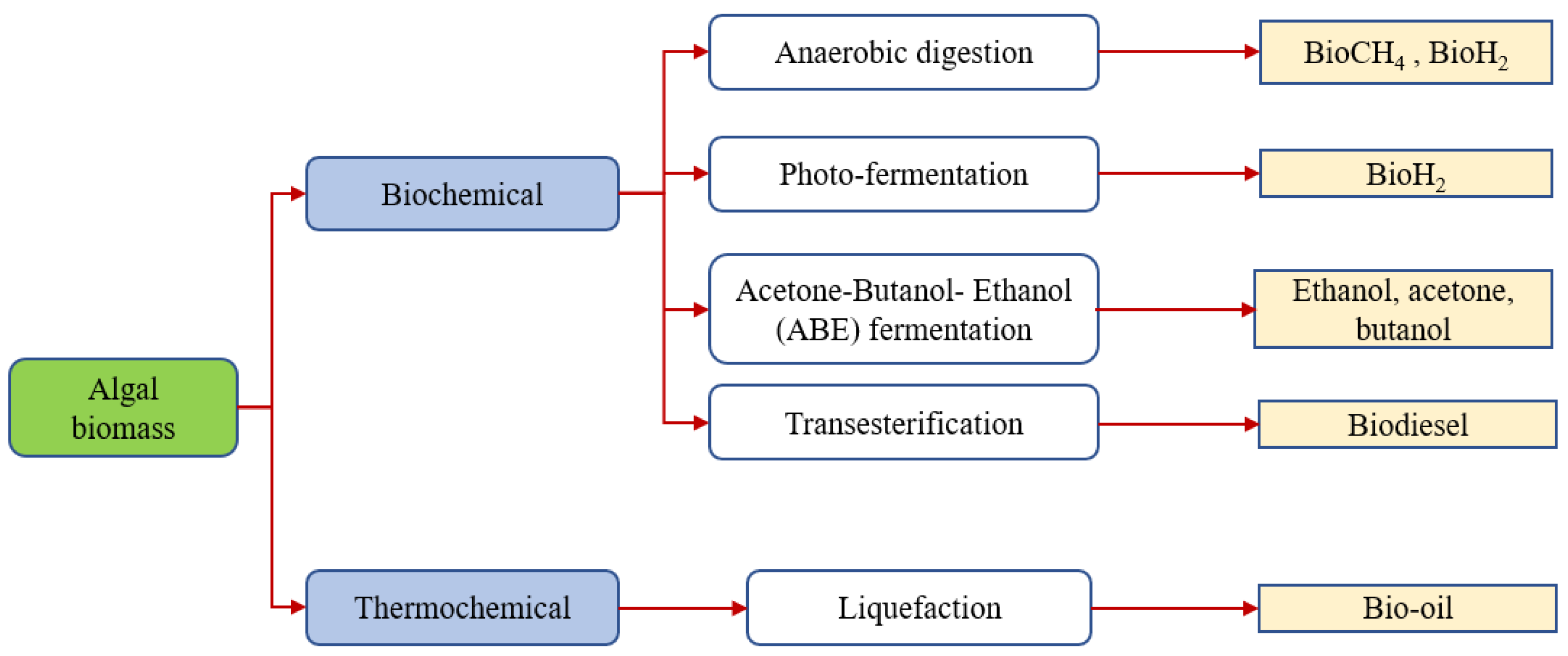
- Transesterification: Transesterification is a crucial step in the conversion of waste oils into biodiesel, which has the potential to completely replace fossil fuel [39]. The production of low-cost biodiesel from waste oils such as household and industrial waste cooking oil, animal fats, and soapstock from vegetable oil refining has been suggested as a viable solution to the waste oil disposal problems [40].
4. Waste Biorefineries
4.1. Organic Waste Biorefineries
- Food waste biorefineries: Sridhar et al. [84] reviewed the advantages and drawbacks of several thermochemical and biochemical processes utilized in food waste conversion. A comparison of numerous technologies shows that anaerobic digestion (AD) is the most promising technology for food waste valorization. AD requires less space, energy, and has the potential to produce renewable energy products, which are important in reducing greenhouse gas emissions. A study by Mirabella et al. [85], discussed the importance of waste characterization and technological maturity of conversion processes in adopting industrial symbiosis in the food industry. According to the findings, waste characterization is required for determining the type and quantity of waste, as well as identifying possible technologies and types of bioproducts to produce. Furthermore, a review by Zhang et al. [35] discusses the advantages of assessing the characteristics of cassava waste in the production of biofuels and biochemicals. Using the input-output-suitable technology strategy, Tsegaye et al. [86] emphasize the importance of aligning the composition of food waste to the desired final products as the first steps in choosing a more effective biorefinery conversion pathway. According to Caldeira et al. [87], some efforts are still needed to improve the efficiency of food waste biorefineries via technology integration. Moreover, the lack of willingness for food industries to share data on the nature of components in the food waste industries hinders the development of new food waste valorization routes [88].
- Municipal waste biorefineries: Nizami et al. [4] assessed the value of generating bioenergy from MSW during Muslim pilgrimage in Makkah. According to the study, the large fraction of organic content in MSW—particularly food waste—offers considerable economic and environmental benefits for developing a waste biorefinery in Makkah. In addition, Saini et al. [89] discussed the features of municipal solid waste biorefineries by considering conversion pathways for the lignocellulosic and organic waste fractions. The authors also examined the extent of research in the organic fraction of MSW when it comes to converting it into bioenergy via the biochemical conversion processes.
- Animal waste biorefineries: For a long time, the valorization of animal manure has been primarily centered on the solid fraction conversion for biogas production; however, new research reveals that interest in using the liquid fraction for bioenergy production is increasing [56]. Moreover, due to the availability of numerous chemical constituents in animal manure, researchers have recently focused on examining the possibilities of producing other products such as bioethanol and biodiesel from the substrate [90]. According to Jung et al. [90], the co-production of biogas, bioethanol, and fertilizer presents a cost-effective way to maximize value from livestock manure. Liu et al. [91] investigated an animal waste biorefinery that combines an AD, liquid digestate electrocoagulation (EC), and solid fiber fungal conversion into methane and fine biochemicals. In their approach, animal manure was first processed by an AD to produce methane gas, which is used to power the biorefinery. EC processed the resultant liquid digestate to recover water. The cellulose-rich solid digestate was then treated with enzyme hydrolysis and fungal fermentation to produce chitin (a polysaccharide containing nitrogen).
4.2. Lignocellulosic Waste Biorefineries
- Agricultural waste biorefineries: Batidas-Oyanedel et al. [92] examined the use of dates and palm residues as feedstocks for waste biorefineries in the Middle East and North Africa (MENA). The authors propose biorefining as a way to add value to date palm residue instead of burning it or using it to build conventional homes. Ginni et al. [93] presented a comprehensive review of the numerous biorefinery routes for the valorization of agricultural residues through the separation and conversion of cellulose, hemicellulose, and lignin fractions into biofuels and other useful products. Finally, the study reveals that the transformation of agricultural residue can be improved through the use of integrated bioprocesses.
- Forest residue biorefineries: In order to assess the opportunities of forestry biorefineries, Stafford et al. [83] identified a total of 129 chemical, thermochemical, biological, and mechanical processing pathways that can lead to the production of 78 distinct bioproducts. The study also includes an assessment of the technology readiness and market potential of biorefinery products. Finally, the authors suggest that bioproduct feasibility assessments need to consider environmental and social sustainability in addition to economics. Additionally, through an example of the pulp and paper industry, a study by Gottumukkala et al. [94] reveals that introducing bioprocess integration results in more appealing carbon conversion yields in the forest waste biorefineries.
5. Integration of Biorefinery Systems
5.1. Integration by Feedstock
5.2. Integration by Products, Byproducts, and Waste
5.3. Integration by Platform
5.4. Integration by Processes
5.5. Integration with Industrial Infrastructure
6. Future Integrated Waste Biorefineries
7. Conclusions
Author Contributions
Funding
Institutional Review Board Statement
Informed Consent Statement
Data Availability Statement
Acknowledgments
Conflicts of Interest
References
- IEA. Net Zero by 2050: A Roadmap for the Global Energy Sector; International Energy Agency: Paris, France, 2021; pp. 18–19. [Google Scholar]
- IPCC. 2018: Global Warming of 1.5 °C. An IPCC Special Report on the Impacts of Global Warming of 1.5 °C above Pre-Industrial Levels and Related Global Greenhouse Gas Emission Pathways, in the Context of Strengthening the Global Response to the Threat of Climate Change, Sustainable Development, and Efforts to Eradicate Poverty; Masson-Delmotte, V., Zhai, P., Pörtner, H.-O., Roberts, D., Skea, J., Shukla, P.R., Pirani, A., Moufouma-Okia, W., Péan, C., Pidcock, R., et al., Eds.; IPCC: Geneva, Switzerland, 2019. [Google Scholar]
- Perea-Moreno, M.-A.; Samerón-Manzano, E.; Perea-Moreno, A.-J. Biomass as Renewable Energy: Worldwide Research Trends. Sustainability 2019, 11, 863. [Google Scholar] [CrossRef] [Green Version]
- Nizami, A.S.; Shahzad, K.; Rehan, M.; Ouda, O.K.M.; Khan, M.Z.; Ismail, I.M.I.; Almeelbi, T.; Basahi, J.M.; Demirbas, A. Developing waste biorefinery in Makkah: A way forward to convert urban waste into renewable energy. Appl. Energy 2017, 186, 189–196. [Google Scholar] [CrossRef]
- Lago, C.; Herrera, I.; Caldés, N.; Lechon, Y. Nexus Bioenergy–Bioeconomy. In The Role of Bioenergy in the Bioeconomy; Lago, C., Caldés, N., Lechón, Y., Eds.; Academic Press: Cambridge, MA, USA, 2019; pp. 3–24. [Google Scholar]
- Lee, S.Y.; Sankaran, R.; Chew, K.W.; Tan, C.H.; Krishnamoorthy, R.; Chu, D.-T.; Show, P.-L. Waste to bioenergy: A review on the recent conversion technologies. BMC Energy 2019, 1, 1–22. [Google Scholar] [CrossRef]
- Forster-Carneiro, T.; Berni, M.D.; Dorileo, I.L.; Rostagno, M.A. Biorefinery study of availability of agriculture residues and wastes for integrated biorefineries in Brazil. Resour. Conserv. Recycl. 2013, 77, 78–88. [Google Scholar] [CrossRef]
- Nizami, A.S.; Rehan, M.; Waqas, M.; Naqvi, M.; Ouda, O.K.M.; Shahzad, K.; Miandad, R.; Khan, M.Z.; Syamsiro, M.; Ismail, I.M.I.; et al. Waste biorefineries: Enabling circular economies in developing countries. Bioresour. Technol. 2017, 241, 1101–1117. [Google Scholar] [CrossRef]
- Ankush, Y.; Khushboo, Y.; Dubey, K.K. Food industry waste biorefineries: Future energy, valuable recovery, and waste treatment. In Refining Biomass Residues for Sustainable Energy and Bioproducts; Academic Press: Cambridge, MA, USA, 2020; pp. 391–406. [Google Scholar]
- Clauser, N.M.; González, G.; Mendieta, C.M.; Kruyeniski, J.; Area, M.C.; Vallejos, M.E. Biomass Waste as Sustainable Raw Material for Energy and Fuels. Sustainability 2021, 13, 794. [Google Scholar] [CrossRef]
- Ng, D.K.S.; Ng, K.S.; Ng, R.T.L. Integrated Biorefineries. In Encyclopedia of Sustainable Technologies; Elsevier: Amsterdam, The Netherlands, 2017. [Google Scholar]
- Takkellapati, S.; Li, T.; Gonzalez, M.A. An Overview of Biorefinery Derived Platform Chemicals from a Cellulose and Hemicellulose Biorefinery. Clean Technol. Environ. Policy 2018, 20, 1615–1630. [Google Scholar] [CrossRef]
- Budzianowski, W.M.; Postawa, K. Total Chain Integration of sustainable biorefinery systems. Appl. Energy 2016, 184, 1432–1446. [Google Scholar] [CrossRef]
- Alibardi, L.; Astrup, T.F.; Asunis, F.; Clarke, W.P.; De Gioannis, G.; Dessì, P.; Lens, P.N.L.; Lavagnolo, M.C.; Lombardi, L.; Muntoni, A.; et al. Organic waste biorefineries: Looking towards implementation. Waste Manag. 2020, 114, 274–286. [Google Scholar] [CrossRef]
- Bisinella, V.; Götze, R.; Conradsen, K.; Damgaard, A.; Christensen, T.H.; Astrup, T.F. Importance of waste composition for Life Cycle Assessment of waste management solutions. J. Clean. Prod. 2017, 164, 1180–1191. [Google Scholar] [CrossRef] [Green Version]
- Lodato, C.; Tonini, D.; Damgaard, A.; Fruergaard Astrup, T. A process-oriented life-cycle assessment (LCA) model for environmental and resource-related technologies (EASETECH). Int. J. Life Cycle Assess. 2020, 25, 73–88. [Google Scholar] [CrossRef]
- Snyder, H. Literature review as a research methodology: An overview and guidelines. J. Bus. Res. 2019, 104, 333–339. [Google Scholar] [CrossRef]
- Fantini, M. Biomass Availability, Potential and Characteristics. In Biorefineries: Targeting Energy, High Value Products and Waste Valorisation; Rabaçal, M., Ferreira, A.F., Silva, C.A.M., Costa, M., Eds.; Springer International Publishing: Cham, Switzerland, 2017; pp. 21–54. [Google Scholar]
- Badgujar, K.; Bhanage, B. Dedicated and Waste Feedstocks for Biorefinery: An Approach to Develop a Sustainable Society. In Waste Biorefinery; Bhaskar, T., Pandey, A., Mohan, S.V., Lee, D.-J., Khanal, S.K., Eds.; Elsevier: Amsterdam, The Netherlands, 2018; pp. 3–38. [Google Scholar]
- Brosowski, A.; Thrän, D.; Mantau, U.; Mahro, B.; Erdmann, G.; Adler, P.; Stinner, W.; Reinhold, G.; Hering, T.; Blanke, C. A review of biomass potential and current utilization—Status quo for 93 biogenic wastes and residues in Germany. Biomass Bioenergy 2016, 95, 257–272. [Google Scholar] [CrossRef] [Green Version]
- Meléndez, J.; Lebel, L.; Stuart, P. A Literature Review of Biomass Feedstocks for a Biorefinery. In Integrated Biorefineries: Design, Analysis, and Optimization, 1st ed.; Paul, R., Stuart, M.M.E.-H., Eds.; CRC Press: Boca Raton, FL, USA, 2013; pp. 432–460. [Google Scholar]
- Martinez-Hernández, E.; Sadhukhan, J. Process Design and Integration Philosophy for Competitive Waste Biorefineries: Example of Levulinic Acid Production From Representative Lignocellulosic Biomasses. In Waste Biorefinery; Bhaskar, T., Pandey, A., Mohan, S.V., Lee, D.-J., Khanal, S.K., Eds.; Elsevier: Amsterdam, The Netherlands, 2018; pp. 695–725. [Google Scholar]
- O’Callaghan, K. Technologies for the Utilisation of Biogenic Waste in the Bioeconomy. Food Chem. 2015, 198, 2–11. [Google Scholar] [CrossRef]
- Chen, P.; Xie, Q.; Addy, M.; Zhou, W.; Liu, Y.; Wang, Y.; Cheng, Y.; Li, K.; Ruan, R. Utilization of municipal solid and liquid wastes for bioenergy and bioproducts production. Bioresour. Technol. 2016, 215, 163–172. [Google Scholar] [CrossRef] [Green Version]
- Chen, P.; Anderson, E.; Addy, M.; Zhang, R.; Cheng, Y.; Peng, P.; Ma, Y.; Fan, L.; Zhang, Y.; Lu, Q.; et al. Breakthrough Technologies for the Biorefining of Organic Solid and Liquid Wastes. Engineering 2018, 4, 574–580. [Google Scholar] [CrossRef]
- Ciria, P.; Barro, R. 3-Biomass resource assessment. In Biomass Supply Chains for Bioenergy and Biorefining; Holm-Nielsen, J.B., Ehimen, E.A., Eds.; Woodhead Publishing: Sawston, UK, 2016; pp. 53–83. [Google Scholar]
- Monlau, F.; Barakat, A.; Trably, E.; Dumas, C.; Steyer, J.-P.; Carrère, H. Lignocellulosic Materials Into Biohydrogen and Biomethane: Impact of Structural Features and Pretreatment. Crit. Rev. Environ. Sci. Technol. 2013, 43, 260–322. [Google Scholar] [CrossRef]
- Kirtania, K. Chapter 4—Thermochemical Conversion Processes for Waste Biorefinery. In Waste Biorefinery; Bhaskar, T., Pandey, A., Mohan, S.V., Lee, D.-J., Khanal, S.K., Eds.; Elsevier: Amsterdam, The Netherlands, 2018; pp. 129–156. [Google Scholar]
- Hashemi, B.; Sarker, S.; Lamb, J.J.; Lien, K.M. Yield improvements in anaerobic digestion of lignocellulosic feedstocks. J. Clean. Prod. 2021, 288, 125447. [Google Scholar] [CrossRef]
- García, R.; Pizarro, C.; Lavín, A.; Bueno, J. Biomass sources for thermal conversion. Techno-economical overview. Fuel 2017, 195, 182–189. [Google Scholar] [CrossRef]
- Sayara, T.; Sánchez, A. A Review on Anaerobic Digestion of Lignocellulosic Wastes: Pretreatments and Operational Conditions. Appl. Sci. 2019, 9, 4655. [Google Scholar] [CrossRef] [Green Version]
- Coma, M.; Martinez-Hernandez, E.; Abeln, F.; Raikova, S.; Donnelly, J.; Arnot, T.C.; Allen, M.J.; Hong, D.D.; Chuck, C.J. Organic waste as a sustainable feedstock for platform chemicals. Faraday Discuss. 2017, 202, 175–195. [Google Scholar] [CrossRef] [PubMed] [Green Version]
- EU. Council Directive 75/442/EEC of 15 July 1975 on waste (OJ L 194 25.07.1975 p. 39). In Documents in European Community Environmental Law, 2nd ed.; Galizzi, P., Sands, P., Eds.; Cambridge University Press: Cambridge, UK, 2006; pp. 617–626. [Google Scholar]
- Saravanan, A.; Hemavathy, R.V.; Sundararaman, T.R.; Jeevanantham, S.; Kumar, P.S.; Yaashikaa, P.R. Solid waste biorefineries. In Refining Biomass Residues for Sustainable Energy and Bioproducts; Kumar, R.P., Gnansounou, E., Raman, J.K., Baskar, G., Eds.; Academic Press: Cambridge, MA, USA, 2020; pp. 3–17. [Google Scholar]
- Zhang, M.; Xie, L.; Yin, Z.; Khanal, S.K.; Zhou, Q. Biorefinery approach for cassava-based industrial wastes: Current status and opportunities. Bioresour. Technol. 2016, 215, 50–62. [Google Scholar] [CrossRef] [PubMed] [Green Version]
- Sánchez, A.S. Chapter Nine—Toward “Zero Liquid Discharge” industrial facilities: Reducing the impact on freshwater resources by reusing industrial and urban wastewaters. In Concepts of Advanced Zero Waste Tools; Hussain, C.M., Ed.; Elsevier: Amsterdam, The Netherlands, 2021; pp. 215–246. [Google Scholar]
- Sánchez, J.; Curt, M.D.; Robert, N.; Fernández, J. Biomass Resources. In The Role of Bioenergy in the Bioeconomy; Academic Press: Cambridge, MA, USA, 2019. [Google Scholar]
- Mumtaz, M.W.; Adnan, A.; Mukhtar, H.; Rashid, U.; Danish, M. Biodiesel production through chemical and biochemical transesterification: Trends, technicalities, and future perspectives. In Clean Energy for Sustainable Development: Resources, Technologies, Sustainability and Policy; Carmen, L., Natalia, C., Lechon, Y., Eds.; Elsevier: Amsterdam, The Netherlands, 2017; pp. 465–485. [Google Scholar]
- Uzun, B.B.; Kılıç, M.; Özbay, N.; Pütün, A.E.; Pütün, E. Biodiesel production from waste frying oils: Optimization of reaction parameters and determination of fuel properties. Energy 2012, 44, 347–351. [Google Scholar] [CrossRef]
- Huynh, L.-H.; Kasim, N.S.; Ju, Y.-H. Chapter 16—Biodiesel Production from Waste Oils. In Biofuels; Pandey, A., Larroche, C., Ricke, S.C., Dussap, C.-G., Gnansounou, E., Eds.; Academic Press: Amsterdam, The Netherlands, 2011; pp. 375–396. [Google Scholar]
- Bhaskar, T.; Pandey, A. Advances in Thermochemical Conversion of Biomass—Introduction. In Recent Advances in Thermo-Chemical Conversion of Biomass; Michael, S., Sukumaran, R.K., Eds.; Elsevier: Amsterdam, The Netherlands, 2015; pp. 3–30. [Google Scholar]
- Kumar, A.; Samadder, S.R. A review on technological options of waste to energy for effective management of municipal solid waste. Waste Manag. 2017, 69, 407–422. [Google Scholar] [CrossRef]
- Ferreira, A.F. Biorefinery Concept. In Biorefineries: Targeting Energy, High Value Products and Waste Valorisation; Rabaçal, M., Ferreira, A.F., Silva, C.A.M., Costa, M., Eds.; Springer International Publishing: Cham, Switzerland, 2017; pp. 1–20. [Google Scholar]
- Maniscalco, M.P.; Volpe, M.; Messineo, A. Hydrothermal carbonization as a valuable tool for energy and environmental applications: A review. Energies 2020, 13, 4098. [Google Scholar] [CrossRef]
- Fitri Faradilla, R.H.; Lucia, L.; Hakovirta, M. Hydrothermal carbonization of soybean hulls for the generation of hydrochar: A promising valorization pathway for low value biomass. Environ. Nanotechnol. Monit. Manag. 2021, 16, 100571. [Google Scholar] [CrossRef]
- Zhuang, X.; Liu, J.; Zhang, Q.; Wang, C.; Zhan, H.; Ma, L. A review on the utilization of industrial biowaste via hydrothermal carbonization. Renew. Sustain. Energy Rev. 2022, 154, 111877. [Google Scholar] [CrossRef]
- Kumar, S.; Ankaram, S. Waste-to-Energy Model/Tool Presentation. In Current Developments in Biotechnology and Bioengineering; Elsevier: Amsterdam, The Netherlands, 2019; pp. 239–258. [Google Scholar]
- Ellacuriaga, M.; García-Cascallana, J.; Gómez, X. Biogas Production from Organic Wastes: Integrating Concepts of Circular Economy. Fuels 2021, 2, 144–167. [Google Scholar] [CrossRef]
- Shrestha, B.; Hernandez, R.; Fortela, D.L.B.; Sharp, W.; Chistoserdov, A.; Gang, D.; Revellame, E.; Holmes, W.; Zappi, M.E. A Review of Pretreatment Methods to Enhance Solids Reduction during Anaerobic Digestion of Municipal Wastewater Sludges and the Resulting Digester Performance: Implications to Future Urban Biorefineries. Appl. Sci. 2020, 10, 9141. [Google Scholar] [CrossRef]
- Sarker, S.; Lamb, J.J.; Hjelme, D.R.; Lien, K.M. A Review of the Role of Critical Parameters in the Design and Operation of Biogas Production Plants. Appl. Sci. 2019, 9, 1915. [Google Scholar] [CrossRef] [Green Version]
- da Silva, A.S.A.; de Sá, L.R.V.; Aguieiras, E.C.G.; de Souza, M.F.; Teixeira, R.S.S.; Cammarota, M.C.; Bon, E.P.S.; Freire, D.M.G.; Ferreira-Leitão, V.S. Productive Chain of Biofuels and Industrial Biocatalysis: Two Important Opportunities for Brazilian Sustainable Development. In Biotechnology of Microbial Enzymes; Elsevier: Amsterdam, The Netherlands, 2017; pp. 545–581. [Google Scholar]
- Sampaio, M.A.; Gonçalves, M.R.; Marques, I.P. Anaerobic digestion challenge of raw olive mill wastewater. Bioresour. Technol. 2011, 102, 10810–10818. [Google Scholar] [CrossRef] [PubMed]
- Malakar, S.; Paul, S.K.; Pou, K.R.J. Biotechnological interventions in beverage production. In Biotechnological Progress and Beverage Consumption; Elsevier: Amsterdam, The Netherlands, 2020; pp. 1–37. [Google Scholar]
- Byadgi, S.A.; Kalburgi, P.B. Production of bioethanol from waste newspaper. Procedia Environ. Sci. 2016, 35, 555–562. [Google Scholar] [CrossRef]
- Khandaker, M.M.; Qiamuddin, K.; Majrashi, A.; Dalorima, T. Bio-ethanol production from fruit and vegetable waste by using saccharomyces cerevisiae. In Bioethanol Technologies; Inambao, F., Ed.; Intechopen: London, UK, 2021. [Google Scholar]
- Khoshnevisan, B.; Duan, N.; Tsapekos, P.; Awasthi, M.K.; Liu, Z.; Mohammadi, A.; Angelidaki, I.; Tsang, D.C.W.; Zhang, Z.; Pan, J. A critical review on livestock manure biorefinery technologies: Sustainability, challenges, and future perspectives. Renew. Sustain. Energy Rev. 2021, 135, 110033. [Google Scholar] [CrossRef]
- Venkata Mohan, S. Reorienting waste remediation towards harnessing bioenergy. In Industrial Wastewater Treatment, Recycling and Reuse; Ranade, V.V., Bhandari, V.M., Eds.; Butterworth-Heinemann: Oxford, UK, 2014; pp. 235–281. [Google Scholar]
- Mehariya, S.; Goswami, R.K.; Verma, P.; Lavecchia, R.; Zuorro, A. Integrated approach for wastewater treatment and biofuel production in microalgae biorefineries. Energies 2021, 14, 2282. [Google Scholar] [CrossRef]
- Poh, P.E.; Gouwanda, D.; Mohan, Y.; Gopalai, A.A.; Tan, H.M. Optimization of wastewater anaerobic digestion using mechanistic and meta-heuristic methods: Current limitations and future opportunities. Water Conserv. Sci. Eng. 2016, 1, 1–20. [Google Scholar] [CrossRef] [Green Version]
- Rajakumar, R.; Meenambal, T.; Banu, J.R.; Yeom, I.T. Treatment of poultry slaughterhouse wastewater in upflow anaerobic filter under low upflow velocity. Int. J. Environ. Sci. Technol. 2011, 8, 149–158. [Google Scholar] [CrossRef] [Green Version]
- Fito, J.; Tefera, N.; Van Hulle, S.W.H. Sugarcane biorefineries wastewater: Bioremediation technologies for environmental sustainability. Chem. Biol. Technol. Agric. 2019, 6, 1–13. [Google Scholar] [CrossRef] [Green Version]
- Zhao, B.; Ma, J.; Zhao, Q.; Laurens, L.; Jarvis, E.; Chen, S.; Frear, C. Efficient anaerobic digestion of whole microalgae and lipid-extracted microalgae residues for methane energy production. Bioresour. Technol. 2014, 161, 423–430. [Google Scholar] [CrossRef]
- Acién, F.G.; Molina, E.; Fernández-Sevilla, J.M.; Barbosa, M.; Gouveia, L.; Sepúlveda, C.; Bazaes, J.; Arbib, Z. Economics of microalgae production. In Microalgae-Based Biofuels and Bioproducts; Gonzalez-Fernandez, C., Muñoz, R., Eds.; Woodhead Publishing: Sawston, UK, 2017; pp. 485–503. [Google Scholar]
- Moreno García, L.; Gariépy, Y.; Barnabé, S.; Raghavan, V. Biorefinery of microalgae biomass cultivated in wastewaters. In Refining Biomass Residues for Sustainable Energy and Bioproducts: Technology, Advances, Life Cycle Assessment, and Economics; Praveen Kumar, R., Jegannathan, K.R., Edgard, G., Baskar, G., Eds.; Academic Press: Cambridge, MA, USA, 2020; pp. 149–180. [Google Scholar]
- Escapa, A.; Mateos, R.; Martínez, E.J.; Blanes, J. Microbial electrolysis cells: An emerging technology for wastewater treatment and energy recovery. From laboratory to pilot plant and beyond. Renew. Sustain. Energy Rev. 2016, 55, 942–956. [Google Scholar] [CrossRef]
- Senthilkumar, K.; Naveen Kumar, M. Generation of bioenergy from industrial waste using microbial fuel cell technology for the sustainable future. In Refining Biomass Residues for Sustainable Energy and Bioproducts: Technology, Advances, Life Cycle Assessment, and Economics; Praveen Kumar, R., Jegannathan, K.R., Edgard, G., Baskar, G., Eds.; Academic Press: Cambridge, MA, USA, 2020; pp. 183–193. [Google Scholar]
- Khan, M.Z.; Nizami, A.S.; Rehan, M.; Ouda, O.K.M.; Sultana, S.; Ismail, I.M.; Shahzad, K. Microbial electrolysis cells for hydrogen production and urban wastewater treatment: A case study of Saudi Arabia. Appl. Energy 2017, 185, 410–420. [Google Scholar] [CrossRef]
- Kadier, A.; Jain, P.; Lai, B.; Kalil, M.S.; Kondaveeti, S.; Alabbosh, K.F.S.; Abu-Reesh, I.M.; Mohanakrishna, G. Biorefinery perspectives of microbial electrolysis cells (MECs) for hydrogen and valuable chemicals production through wastewater treatment. Biofuel Res. J. 2020, 7, 1128–1142. [Google Scholar] [CrossRef] [Green Version]
- Fudge, T.; Bulmer, I.; Bowman, K.; Pathmakanthan, S.; Gambier, W.; Dehouche, Z.; Al-Salem, S.M.; Constantinou, A. Microbial Electrolysis Cells for Decentralised Wastewater Treatment: The Next Steps. Water 2021, 13, 445. [Google Scholar] [CrossRef]
- Saravanan, A.; Karishma, S.; Kumar, P.S.; Yaashikaa, P.R.; Jeevanantham, S.; Gayathri, B. Microbial electrolysis cells and microbial fuel cells for biohydrogen production: Current advances and emerging challenges. Biomass Convers. Biorefin. 2020. Available online: https://link.springer.com/article/10.1007/s13399-020-00973-x (accessed on 13 July 2021). [CrossRef]
- Escapa, A.; San-Martín, M.I.; Morán, A. Potential use of microbial electrolysis cells in domestic wastewater treatment plants for energy recovery. Front. Energy Res. 2014, 2, 19. [Google Scholar] [CrossRef] [Green Version]
- Seelam, J.S.; Maesara, S.A.; Mohanakrishna, G.; Patil, S.A.; ter Heijne, A.; Pant, D. Resource recovery from wastes and wastewaters using bioelectrochemical systems. In Waste Biorefinery; Elsevier: Amsterdam, The Netherlands, 2018; pp. 535–570. [Google Scholar]
- Mohsenpour, S.F.; Hennige, S.; Willoughby, N.; Adeloye, A.; Gutierrez, T. Integrating micro-algae into wastewater treatment: A review. Sci. Total Environ. 2021, 752, 142168. [Google Scholar] [CrossRef] [PubMed]
- Khetkorn, W.; Rastogi, R.P.; Incharoensakdi, A.; Lindblad, P.; Madamwar, D.; Pandey, A.; Larroche, C. Microalgal hydrogen production—A review. Bioresour. Technol. 2017, 243, 1194–1206. [Google Scholar] [CrossRef] [PubMed]
- Nagarajan, D.; Lee, D.-J.; Kondo, A.; Chang, J.-S. Recent insights into biohydrogen production by microalgae—From biophotolysis to dark fermentation. Bioresour. Technol. 2017, 227, 373–387. [Google Scholar] [CrossRef] [PubMed]
- Dalena, F.; Senatore, A.; Tursi, A.; Basile, A. 17-Bioenergy production from second- and third-generation feedstocks. In Bioenergy Systems for the Future; Dalena, F., Basile, A., Rossi, C., Eds.; Woodhead Publishing: Sawston, UK, 2017; pp. 559–599. [Google Scholar]
- Bahr, M.; Díaz, I.; Dominguez, A.; Gonzalez Sanchez, A.; Muñoz, R. Microalgal-biotechnology as a platform for an integral biogas upgrading and nutrient removal from anaerobic effluents. Environ. Sci. Technol. 2014, 48, 573–581. [Google Scholar] [CrossRef]
- Ren, H.-Y.; Liu, B.-F.; Kong, F.; Zhao, L.; Ren, N.-Q. Sequential generation of hydrogen and lipids from starch by combination of dark fermentation and microalgal cultivation. RSC Adv. 2015, 5, 76779–76782. [Google Scholar] [CrossRef]
- Chen, Y.D.; Ho, S.H.; Nagarajan, D.; Ren, N.Q.; Chang, J.S. Waste biorefineries-integrating anaerobic digestion and microalgae cultivation for bioenergy production. Curr. Opin. Biotechnol. 2018, 50, 101–110. [Google Scholar] [CrossRef]
- Vermuë, M.H.; Eppink, M.H.M.; Wijffels, R.H.; Van Den Berg, C. Multi-product microalgae biorefineries: From concept towards reality. Trends Biotechnol. 2018, 36, 216–227. [Google Scholar]
- Dahiya, S.; Kumar, A.N.; Shanthi Sravan, J.; Chatterjee, S.; Sarkar, O.; Mohan, S.V. Food waste biorefinery: Sustainable strategy for circular bioeconomy. Bioresour. Technol. 2018, 248, 2–12. [Google Scholar] [CrossRef] [PubMed]
- Chandra, R.; Castillo-Zacarías, C.; Delgado, P.A.V.; Parra-Saldívar, R. A biorefinery approach for dairy wastewater treatment and product recovery towards establishing a biorefinery complexity index. J. Clean. Prod. 2018, 183, 1184–1196. [Google Scholar] [CrossRef]
- Stafford, W.; De Lange, W.; Nahman, A.; Chunilall, V.; Lekha, P.; Andrew, J.; Johakimu, J.; Sithole, B.; Trotter, D. Forestry biorefineries. Renew. Energy 2020, 154, 461–475. [Google Scholar] [CrossRef]
- Sridhar, A.; Kapoor, A.; Kumar, P.S.; Ponnuchamy, M.; Balasubramanian, S.; Prabhakar, S. Conversion of food waste to energy: A focus on sustainability and life cycle assessment. Fuel 2021, 302, 121069. [Google Scholar] [CrossRef]
- Mirabella, N.; Castellani, V.; Sala, S. Current options for the valorization of food manufacturing waste: A review. J. Clean. Prod. 2014, 65, 28–41. [Google Scholar] [CrossRef] [Green Version]
- Tsegaye, B.; Jaiswal, S.; Jaiswal, A.K. Food Waste Biorefinery: Pathway towards Circular Bioeconomy. Foods 2021, 10, 1174. [Google Scholar] [CrossRef]
- Caldeira, C.; Vlysidis, A.; Fiore, G.; De Laurentiis, V.; Vignali, G.; Sala, S. Sustainability of food waste biorefinery: A review on valorisation pathways, techno-economic constraints, and environmental assessment. Bioresour. Technol. 2020, 312, 123575. [Google Scholar] [CrossRef]
- Kokossis, A.C.; Koutinas, A.A. Food waste as a renewable raw material for the development of integrated biorefineries: Current status and future potential. In Integrated Biorefineries: Design, Analysis, and Optimization, 1st ed.; Paul, R., Stuart, M.M.E.-H., Eds.; CRC Press: Boca Raton, FL, USA, 2013; pp. 469–491. [Google Scholar]
- Saini, J.K.; Kumar, G.; Singh, S.; Hemansi; Kuhad, R.C. Chapter 8—Municipal solid waste biorefinery for sustainable production of bioenergy. In Waste Biorefinery; Bhaskar, T., Varjani, S., Pandey, A., Rene, E.R., Eds.; Elsevier: Amsterdam, The Netherlands, 2021; pp. 207–233. [Google Scholar]
- Jung, S.; Shetti, N.P.; Reddy, K.R.; Nadagouda, M.N.; Park, Y.-K.; Aminabhavi, T.M.; Kwon, E.E. Synthesis of different biofuels from livestock waste materials and their potential as sustainable feedstocks—A review. Energy Convers. Manag. 2021, 236, 114038. [Google Scholar] [CrossRef]
- Liu, Z.; Liao, W.; Liu, Y. A sustainable biorefinery to convert agricultural residues into value-added chemicals. Biotechnol. Biofuels 2016, 9, 197. [Google Scholar] [CrossRef] [Green Version]
- Bastidas-Oyanedel, J.R.; Fang, C.; Almardeai, S.; Javid, U.; Yousuf, A.; Schmidt, J.E. Waste biorefinery in arid/semi-arid regions. Bioresour. Technol. 2016, 215, 21–28. [Google Scholar] [CrossRef] [PubMed]
- Ginni, G.; Kavitha, S.; Kannah, Y.; Bhatia, S.K.; Kumar, A.; Rajkumar, M.; Kumar, G.; Pugazhendhi, A.; Chi, N.T.L. Valorization of agricultural residues: Different biorefinery routes. J. Environ. Chem. Eng. 2021, 9, 105435. [Google Scholar]
- Gottumukkala, L.D.; Haigh, K.; Collard, F.-X.; Van Rensburg, E.; Görgens, J. Opportunities and prospects of biorefinery-based valorisation of pulp and paper sludge. Bioresour. Technol. 2016, 215, 37–49. [Google Scholar] [CrossRef] [PubMed]
- Stuart, P.R.; El-Halwagi, M.M. Integrated Biorefineries: Design, Analysis, and Optimization; CRC Press: Boca Raton, FL, USA, 2012; pp. 36–58. [Google Scholar]
- Özdenkçi, K.; De Blasio, C.; Muddassar, H.R.; Melin, K.; Oinas, P.; Koskinen, J.; Sarwar, G.; Järvinen, M. A novel biorefinery integration concept for lignocellulosic biomass. Energy Convers. Manag. 2017, 149, 974–987. [Google Scholar] [CrossRef] [Green Version]
- Gopinath, A.; Bahurudeen, A.; Appari, S.; Nanthagopalan, P. A circular framework for the valorisation of sugar industry wastes: Review on the industrial symbiosis between sugar, construction and energy industries. J. Clean. Prod. 2018, 203, 89–108. [Google Scholar] [CrossRef]
- Yazan, D.M.; Romano, V.A.; Albino, V. The design of industrial symbiosis: An input–output approach. J. Clean. Prod. 2016, 129, 537–547. [Google Scholar] [CrossRef]
- Li, X. Industrial Ecology and Industrial Symbiosis-Definitions and Development Histories. In Industrial Ecology and Industry Symbiosis for Environmental Sustainability: Definitions, Frameworks and Applications; Li, X., Ed.; Springer International Publishing: Cham, Switzerland, 2018; pp. 9–38. [Google Scholar]
- Walmsley, T.G.; Ong, B.H.Y.; Klemeš, J.J.; Tan, R.R.; Varbanov, P.S. Circular Integration of processes, industries, and economies. Renew. Sustain. Energy Rev. 2019, 107, 507–515. [Google Scholar] [CrossRef]
- Kataki, R.; Chutia, R.S.; Mishra, M.; Bordoloi, N.; Saikia, R.; Bhaskar, T. Feedstock suitability for thermochemical processes. In Recent Advances in Thermo-Chemical Conversion of Biomass; Elsevier: Amsterdam, The Netherlands, 2015; pp. 31–74. [Google Scholar]
- Mathew, A.K.; Abraham, A.; Mallapureddy, K.K.; Sukumaran, R.K. Chapter 9—Lignocellulosic Biorefinery Wastes, or Resources in; Bhaskar, T., Pandey, A., Mohan, S.V., Lee, D.-J., Khanal, S., Eds.; Elsevier: Amsterdam, The Netherlands, 2018; pp. 267–297. [Google Scholar]
- Yao, Z.; Li, W.; Kan, X.; Dai, Y.; Tong, Y.W.; Wang, C.-H. Anaerobic digestion and gasification hybrid system for potential energy recovery from yard waste and woody biomass. Energy 2017, 124, 133–145. [Google Scholar] [CrossRef]
- Monlau, F.; Francavilla, M.; Sambusiti, C.; Antoniou, N.; Solhy, A.; Libutti, A.; Zabaniotou, A.; Barakat, A.; Monteleone, M. Toward a functional integration of anaerobic digestion and pyrolysis for a sustainable resource management. Comparison between solid-digestate and its derived pyrochar as soil amendment. Appl. Energy 2016, 169, 652–662. [Google Scholar] [CrossRef]
- Li, W.; Lu, C.; An, G.; Zhang, Y.; Tong, Y.W. Integration of high-solid digestion and gasification to dispose horticultural waste and chicken manure. Chin. J. Chem. Eng. 2018, 26, 1145–1151. [Google Scholar] [CrossRef]
- Antoniou, N.; Monlau, F.; Sambusiti, C.; Ficara, E.; Barakat, A.; Zabaniotou, A. Contribution to Circular Economy options of mixed agricultural wastes management: Coupling anaerobic digestion with gasification for enhanced energy and material recovery. J. Clean. Prod. 2019, 209, 505–514. [Google Scholar] [CrossRef]
- Monlau, F.; Sambusiti, C.; Antoniou, N.; Barakat, A.; Zabaniotou, A. A new concept for enhancing energy recovery from agricultural residues by coupling anaerobic digestion and pyrolysis process. Appl. Energy 2015, 148, 32–38. [Google Scholar] [CrossRef]
- Mohanakrishna, G.; Mohan, S.V.; Sarma, P.N. Utilizing acid-rich effluents of fermentative hydrogen production process as substrate for harnessing bioelectricity: An integrative approach. Int. J. Hydrogen Energy 2010, 35, 3440–3449. [Google Scholar] [CrossRef]
- Kan, X.; Yao, Z.; Zhang, J.; Tong, Y.W.; Yang, W.; Dai, Y.; Wang, C.-H. Energy performance of an integrated bio-and-thermal hybrid system for lignocellulosic biomass waste treatment. Bioresour. Technol. 2017, 228, 77–88. [Google Scholar] [CrossRef]
- Clausen, L.R.; Butera, G.; Jensen, S.H. Integration of anaerobic digestion with thermal gasification and pressurized solid oxide electrolysis cells for high efficiency bio-SNG production. Energy 2019, 188, 116018. [Google Scholar] [CrossRef]
- Bell, G.; Schuck, S.; Jungmeier, G.; Wellisch, M.; Felby, C.; Jorgensen, H.; Stichnothe, H.; Clancy, M.; De Bari, I.; Kimura, S. EA Bioenergy Task 42 Biorefining: Sustainable and Synergetic Processing of Biomass into Marketable Food & Feed Ingredients, Chemicals, mateRials and Energy (Fuels, Power, Heat); van Ree, R., van Zeeland, A.N.T., Eds.; IEA Bioenergy Task 42: Wageningen, The Netherlands, 2014. [Google Scholar]
- Jungmeier, G. The Biorefinery Complexity Index; Working Document—2014-07-09; IEA-Bioenergy Task 42 Biorefining: Wageningen, The Netherlands, 2014; p. 36. [Google Scholar]
- Gnansounou, E.; Pandey, A. Classification of Biorefineries Taking into Account Sustainability Potentials and Flexibility. In Life-Cycle Assessment of Biorefineries; Kostas, M., Ed.; Elsevier: Amsterdam, The Netherlands, 2017; pp. 1–39. [Google Scholar]
- Hingsamer, M.; Jungmeier, G. Biorefineries. In The Role of Bioenergy in the Bioeconomy: Resources, Technologies, Sustainability and Policy; Carmen, L., Natalia, C., Lechon, Y., Eds.; Academic Press: Cambridge, MA, USA, 2019; pp. 179–222. [Google Scholar]
- Stephen, R.; Hughes; William, R.; Gibbons, B.R.M.; Rich, J.O. Sustainable Multipurpose Biorefineries for Third-Generation Biofuels and Value-Added Co-Products. In Biofuels-Economy, Environment and Sustainability; Fang, Z., Ed.; InTechOpen: London, UK, 2013. [Google Scholar]
- Park, J.; Lee, B.; Tian, D.; Jun, H. Bioelectrochemical enhancement of methane production from highly concentrated food waste in a combined anaerobic digester and microbial electrolysis cell. Bioresour. Technol. 2018, 247, 226–233. [Google Scholar] [CrossRef]
- Jungmeier, G.; Buchsbaum, M.; Van Ree, R.; De Jong, E.; Stichnothe, H.; De Bari, I. Upgrading strategies for industrial infrastructures–integration of biorefineries in existing industrial infrastructure. IEABioenergy 2014, 16, 2014. [Google Scholar]
- Colpan, C.O.; Hamdullahpur, F.; Dincer, I.; Yoo, Y. Effect of gasification agent on the performance of solid oxide fuel cell and biomass gasification systems. Int. J. Hydrogen Energy 2010, 35, 5001–5009. [Google Scholar] [CrossRef] [Green Version]
- Hameed, Z.; Aslam, M.; Khan, Z.; Maqsood, K.; Atabani, A.E.; Ghauri, M.; Khurram, M.S.; Rehan, M.; Nizami, A.-S. Gasification of municipal solid waste blends with biomass for energy production and resources recovery: Current status, hybrid technologies and innovative prospects. Renew. Sustain. Energy Rev. 2021, 136, 110375. [Google Scholar] [CrossRef]
- Bui, M.; Zhang, D.; Fajardy, M.; Mac Dowell, N. Delivering carbon negative electricity, heat and hydrogen with BECCS–Comparing the options. Int. J. Hydrogen Energy 2021, 46, 15298–15321. [Google Scholar] [CrossRef]
- Carbo, M. Biomass-Based Industrial CO2 Sources: Biofuels Production with CCS; United Nations Industrial Development Organization: Vienna, Austria, 2011. [Google Scholar]
- Kraxner, F.; Aoki, K.; Leduc, S.; Kindermann, G.; Fuss, S.; Yang, J.; Yamagata, Y.; Tak, K.-I.; Obersteiner, M. BECCS in South Korea—Analyzing the negative emissions potential of bioenergy as a mitigation tool. Renew. Energy 2014, 61, 102–108. [Google Scholar] [CrossRef]
- Beal, C.M.; Archibald, I.; Huntley, M.E.; Greene, C.H.; Johnson, Z.I. Integrating Algae with Bioenergy Carbon Capture and Storage (ABECCS) Increases Sustainability. Earth′s Future 2018, 6, 524–542. [Google Scholar] [CrossRef]
- Poblete, I.B.S.; Araújo, O.D.Q.F.; de Medeiros, J.L. Sewage-water treatment with bio-energy production and carbon capture and storage. Chemosphere 2022, 286, 131763. [Google Scholar] [CrossRef] [PubMed]
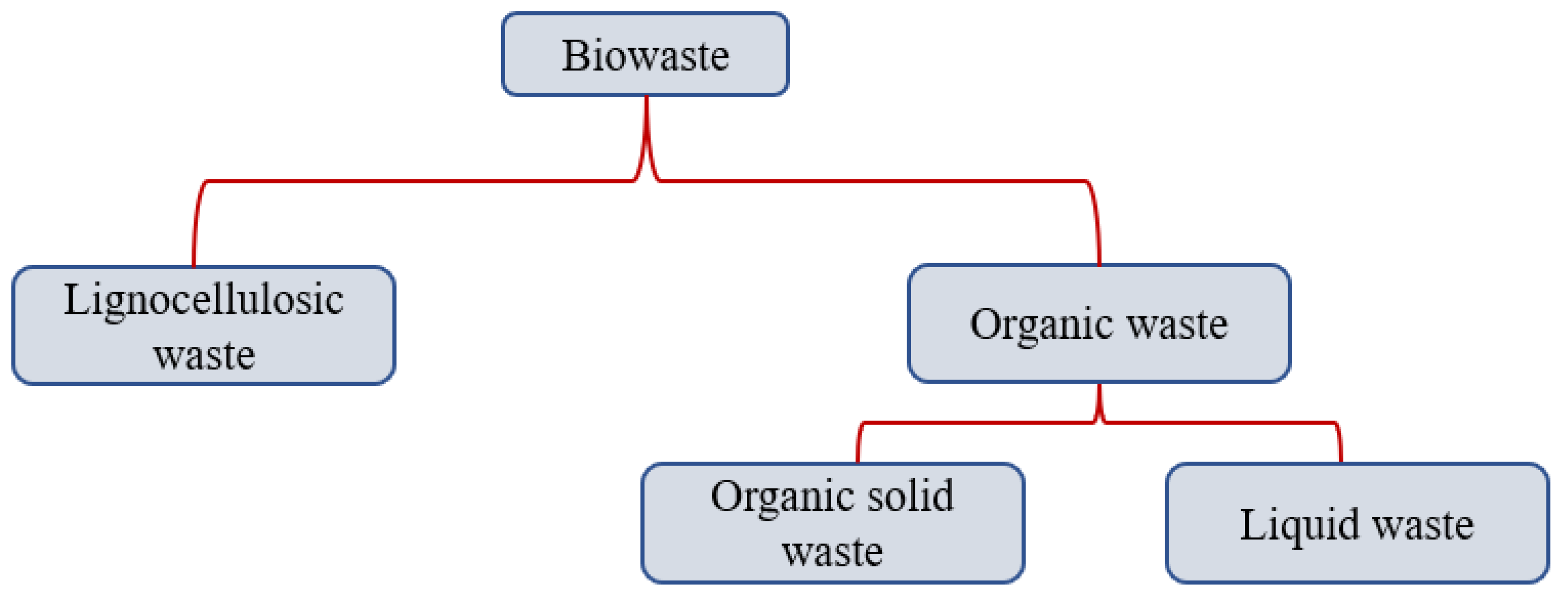
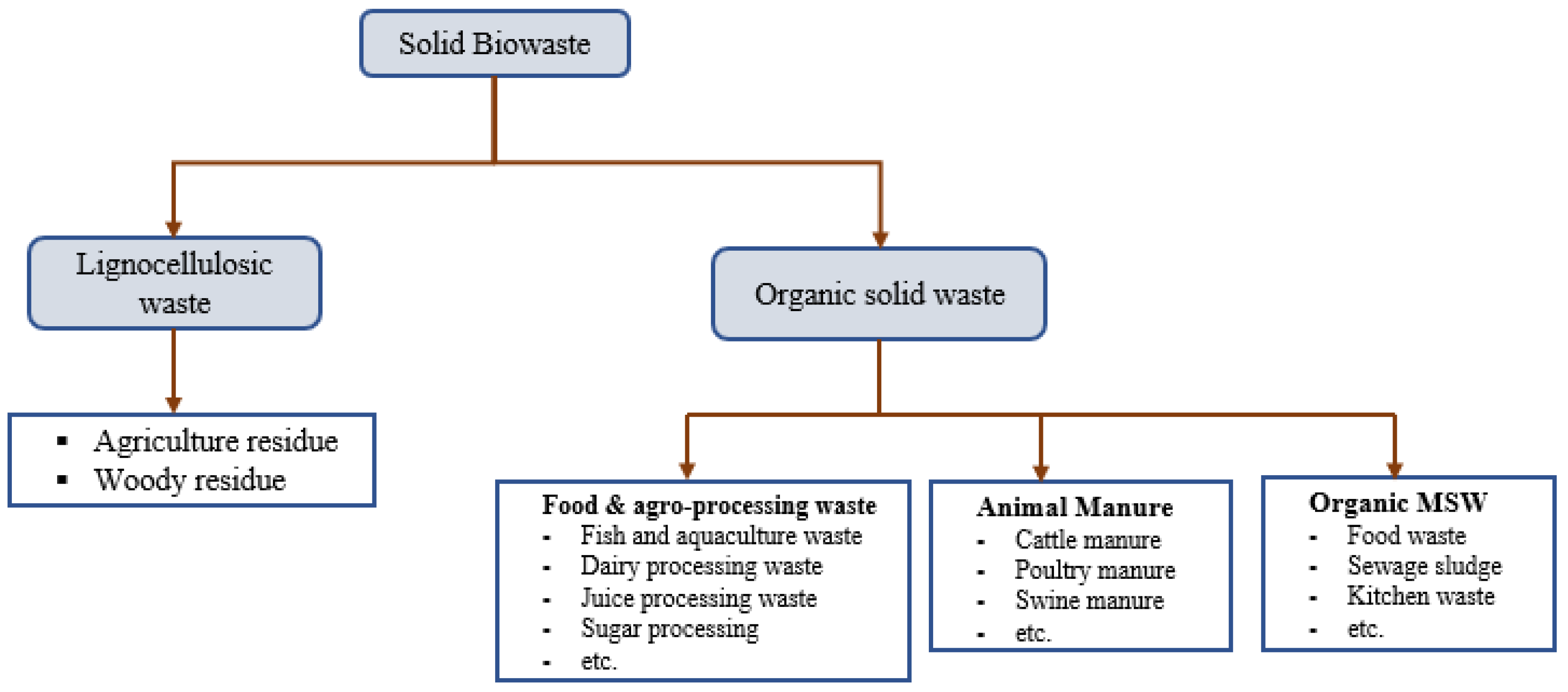

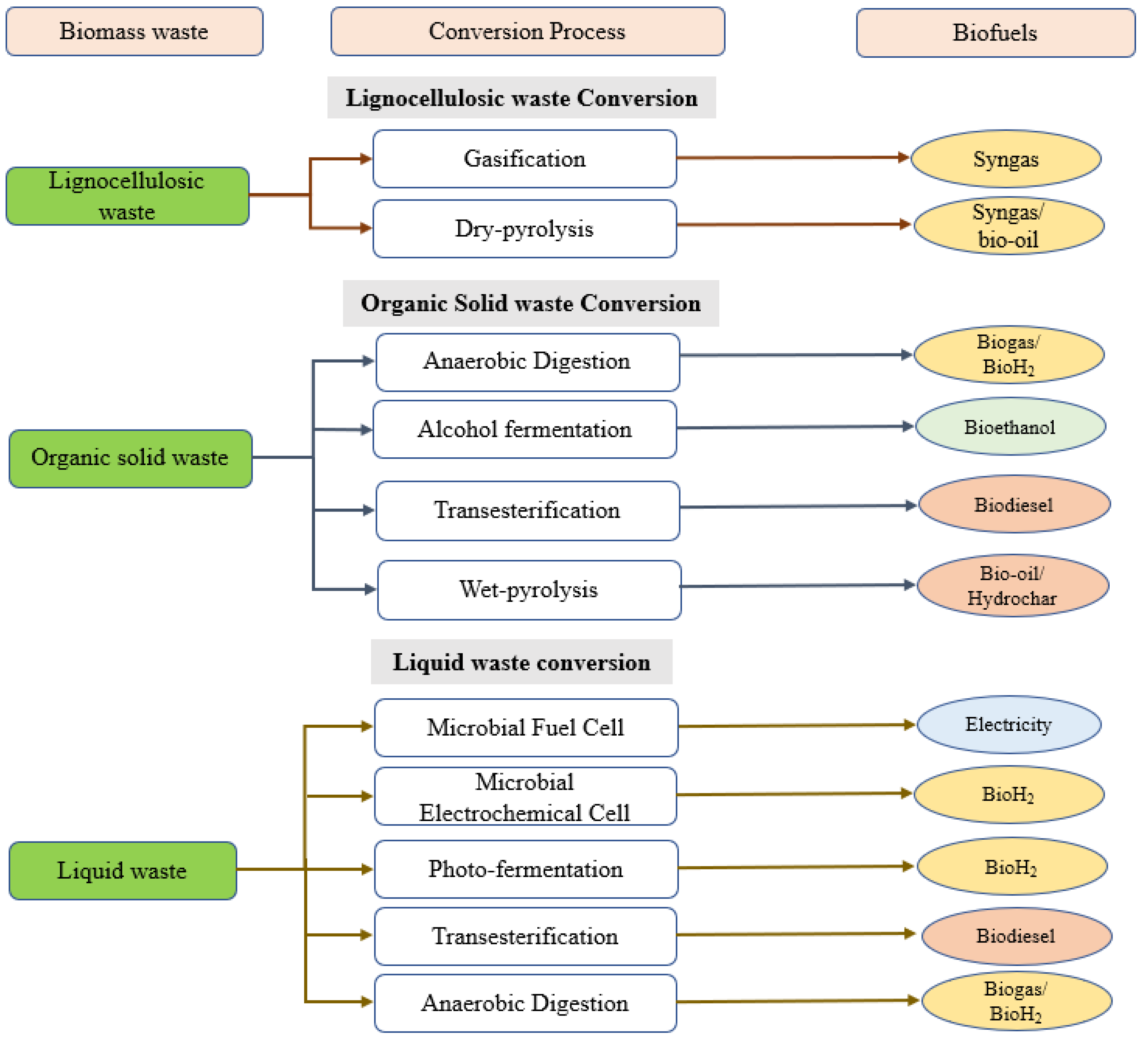

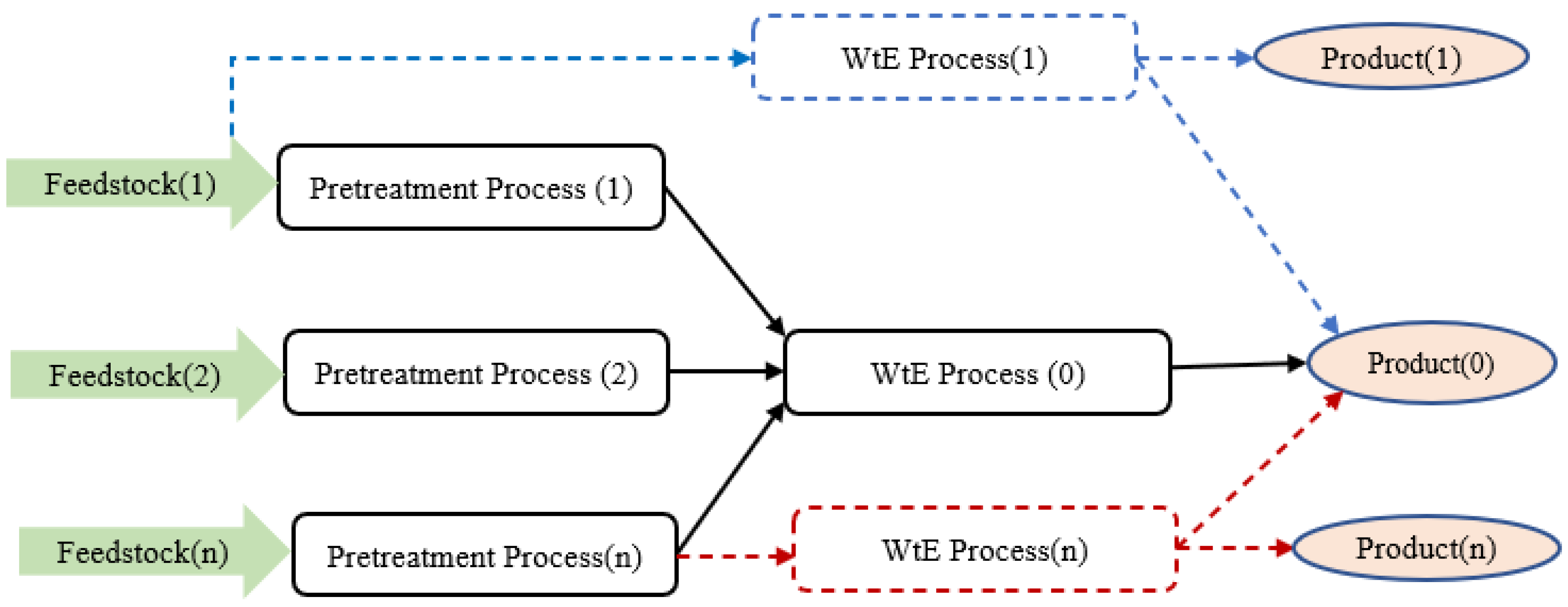
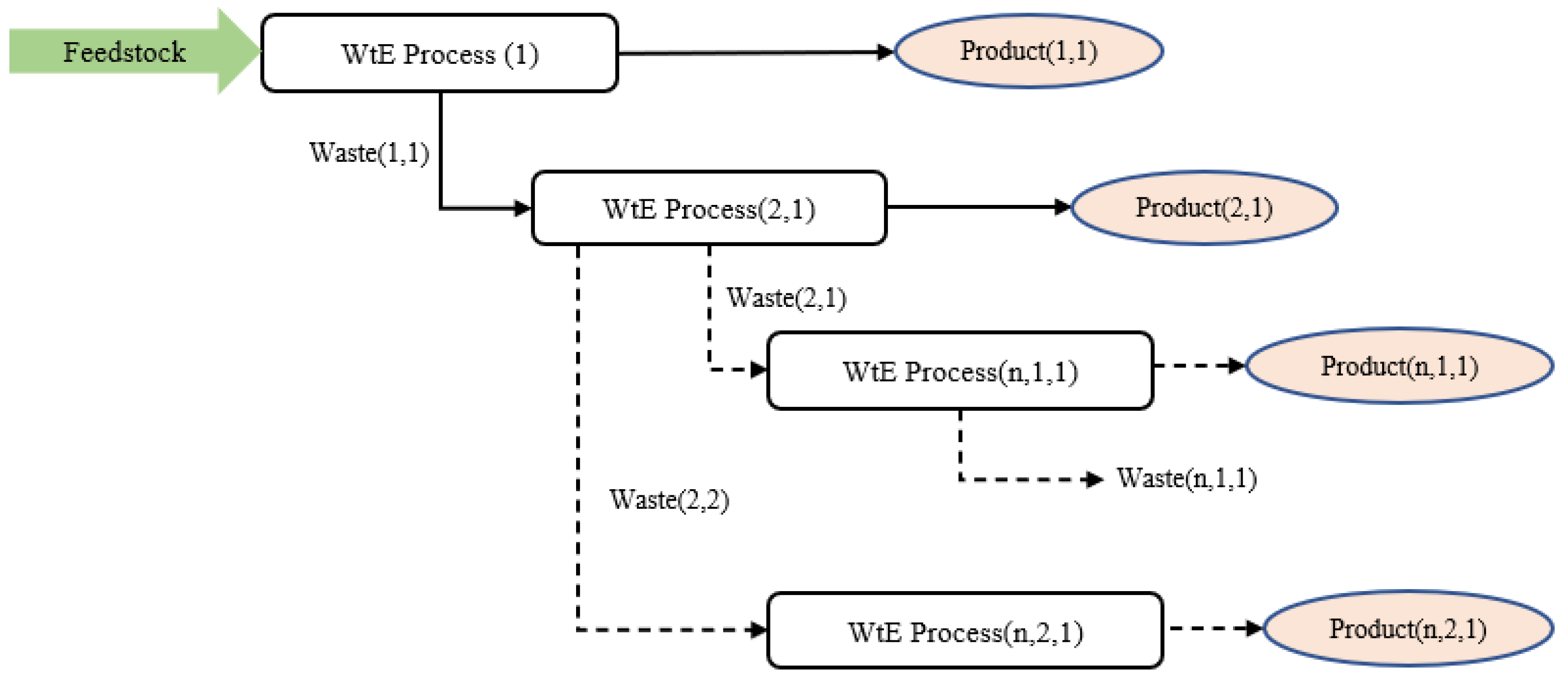
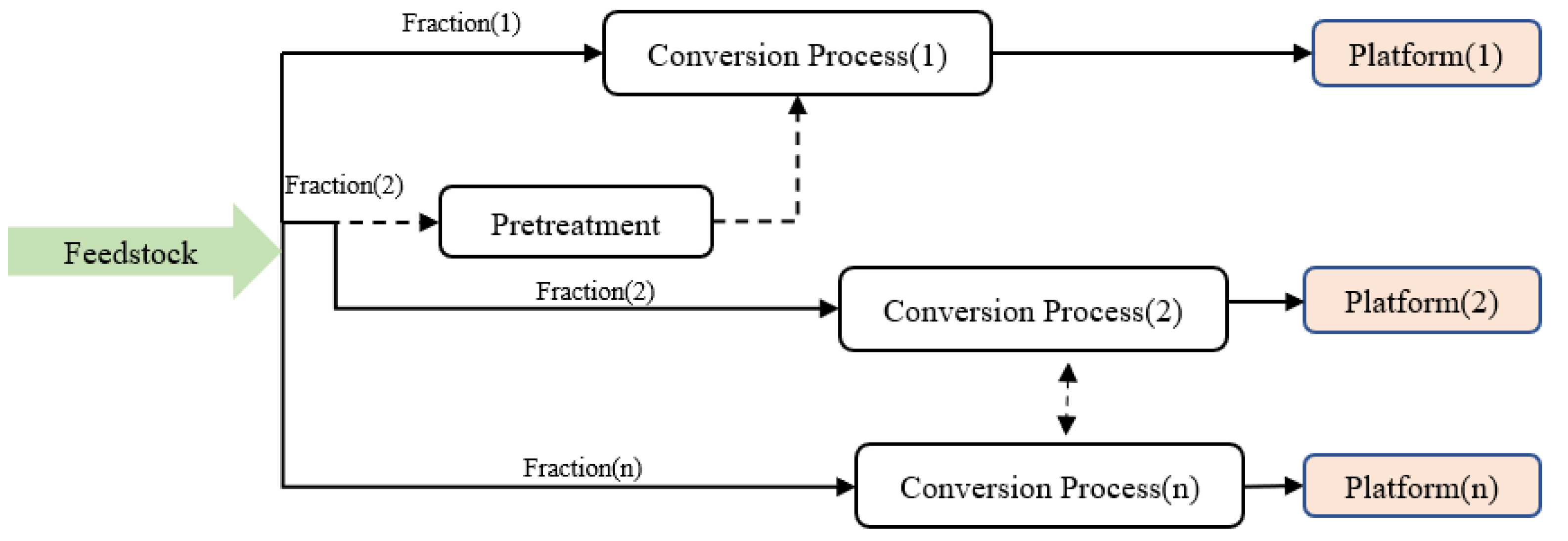
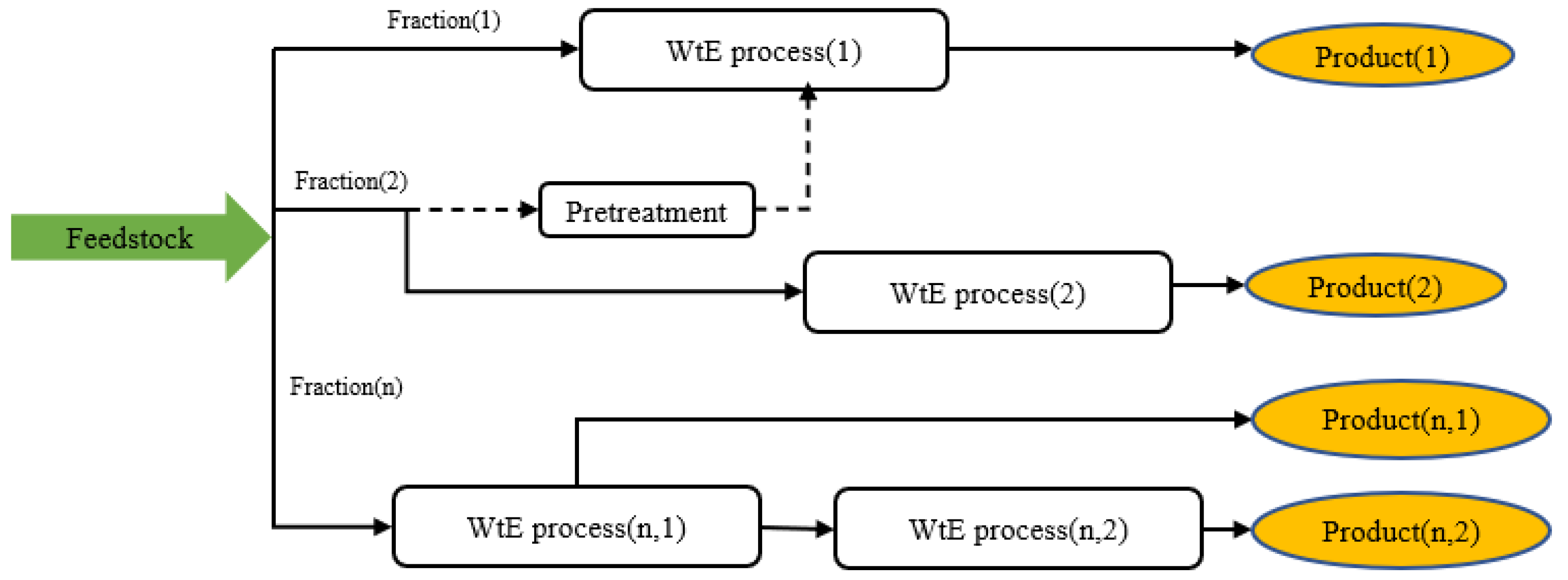
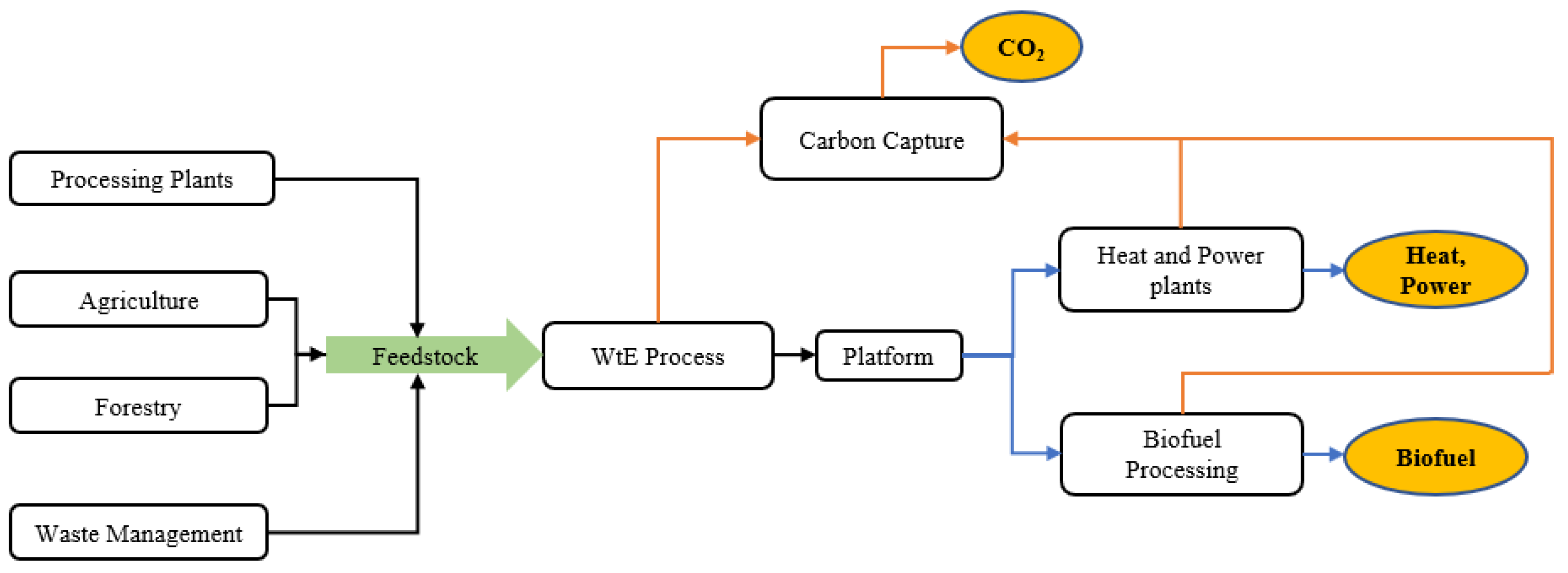
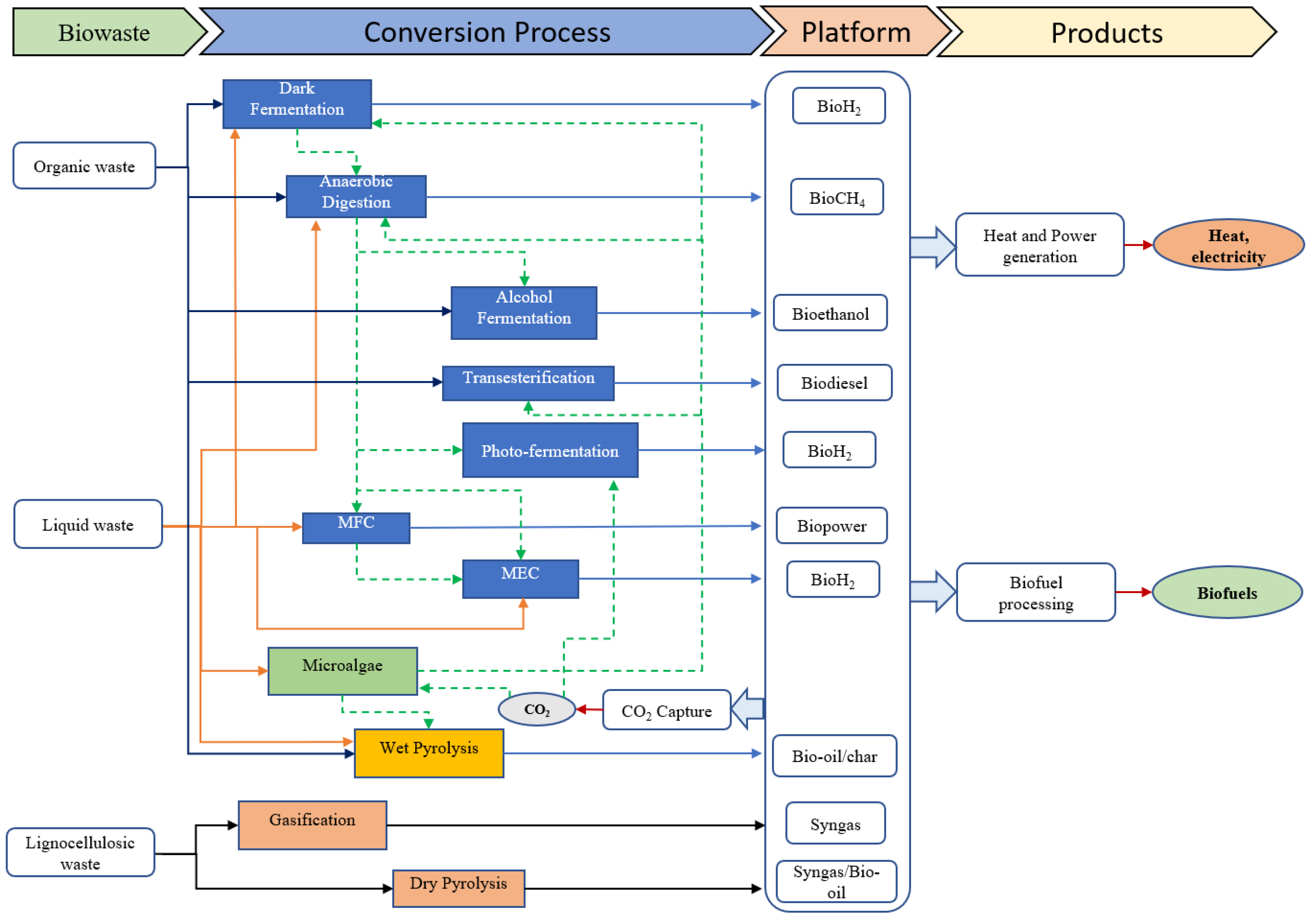
| Technology | Liquid Waste | Bioenergy | Challenges | References |
|---|---|---|---|---|
| Conventional AD | Water ponds | Biogas |
| [59] |
| Upflow anaerobic sludge blanket, UASB | Industrial, municipal wastewaters | Biogas |
| [52,60,61] |
| Photobiological hydrogen production, Anaerobic Digestion | Agricultural, industrial, municipal wastewaters | Algal biomass, Hydrogen, methane |
| [62,63,64] |
| Microbial fuel cells (MFCs) | Agricultural, industrial, municipal wastewaters | Bioelectricity |
| [65,66] |
| Microbial Electrolysis Cells (MEC) | Agricultural, industrial, municipal wastewaters | Biohydrogen |
| [67,68,69] |
| Transesterification (Acid/Base/Enzyme catalyst) | Household and industrial cooking waste oils from vegetable oil, animal fats | Biodiesel | Chemical-catalyzed:
| [38,40] |
| Primary Feedstock/Process | Primary Product | Secondary Feedstock/Prosess | Secondary Product | Reference |
|---|---|---|---|---|
| Yard waste/AD | Biogas 2930 Nm3d−1 | AD residue & woody biomass/gasification | Syngas 17.17 Nm3h−1 LHV: 5.17 MJ/Nm3 | [103] |
| Mixed animal manure & agricultural residues/AD | Biogas | AD digestate/Pyrolysis | Bio-oil: 51 wt% Biochar: 34.0 wt% Syngas: 15.0 wt% | [104] |
| Grass & Chicken manure/AD | Biogas 237 mL (gVS)−1 | AD digestate & woodchips/Gasification | Syngas 15.75 Nm3h−1 LHV 8.1 MJ/kg | [105] |
| Mixed agricultural wastes (pig manure, cow manure, maize and triticale silages, and cereal bran)/AD | Biogas 9477 Nm3d−1 | AD digestate/Gasification | Syngas 65.5 wt% LHV: 2.88 MJ/Nm3 | [106] |
| Lignocellulosic waste & animal manure | Biogas 5150 Nm3d−1 61 % v/v | AD digestate/Pyrolysis | Bio-oil: 58.4 wt% Biochar: 32.0 wt% Syngas: 8.8 %wt, 15.7 MJ/Nm3 | [107] |
| Wastewater/AD | Biohydrogen 1.16 mol H2 (kgCOD)−1 | AD effluent/MFC | Bioelectricity 176.35 J/kgCOD/m3 | [108] |
| Lignocellulosic biomass wastes/AD Waste type 1: 18.68 MJ/kg (HHV) Waste type 2: 17.87 MJ/kg (HHV) Waste type 3: 21.55 MJ/kg (HHV) | Biogas 0.2 kJ/kgTS 0.2 kJ/kgTS 0.5 kJ/kgTS | AD digestate/Gasification | Syngas HHV: 2.5 MJ/Nm3 HHV: 2.4 MJ/Nm3 HHV: 2.6 MJ/Nm3 | [109] |
| Animal manure/AD Feedstock: HHV 19.39 MJ/Kg 51.5 MWth | Biogas 49 % LHV (dry) 25 MWth | AD digestate/Gasification/Solid Oxide electrolysis cell | Synthetic Natural Gas 138% LHV (dry) 71.1 MWth | [110] |
| Feedstock | Platforms | Processes | Products | BCI | References |
|---|---|---|---|---|---|
| Woodchips | 3-Platforms (C5 & C6 sugar, electricity and heat, lignin) | Pyrolysis, fermentation, combustion | Phenols, bioethanol, electricity, and heat | 29 | [112,114] |
| Algae | 4-platform(biogas, biomethane, oil, electricity and heat) | Anaerobic Digestion, Combustion, Esterification | Fertilizer, biodiesel, fertilizer, omega 3, electricity and heat, glycerin | 35 | [114] |
| Straw | 3-platform (pyrolysis oil, syngas, and electricity and heat) | Pyrolysis, gasification, combustion, methanol synthesis, FT-synthesis | Methanol, electricity and heat, biofuels | 25 | [114] |
| Wood chips | 2-platform (syngas, electricity and heat) | Steam gasification, combustion, Fischer-Tropsch (FT) Synthesis | FT-diesel, FT-gasoline, wax, electricity and heat | 16 | [112] |
| Oil based residues | 1-Platform(Bio-oil) | Esterification | Biodiesel, Bio-oil, gycerine and fertilizer | 8 | [113] |
| Feedstock | Technology | Industry Infrastructure | Products | Reference |
|---|---|---|---|---|
| Forest biomass | Combustion | BECCS, Biomass-fired CHP plant | CCS: 0.9–1.84 tCO2/tdm* Heat: 10.18 GJ/tdm* Electricity: 6.48 GJ/tdm* | [122] |
| Wood | Gasification | Solid Oxide Fuel Cell-based CHP | Heat: Air 4877 MJ/tdm*, Steam: 967 MJ/tdm* Electricity: Air 2 GJ/tdm*, Steam: 4.5 GJ/tdm* | [118] |
| Eucalyptus biomass | Combustion | Biomass-fired CHP plant, CCS & algae growth and utilization. | CCS: 85.4 tCO2/d Heat: 419 GJ/d (internally consumed) Electricity: 177 GJ/d | [123] |
| Sewage water (40,000 m3/d 10 kgCOD/m3) | Anaerobic & Aerobic Digestion | Sewage water treatment, biogas-fired CHP plant & CCS | CCS: 0.6 kgCO2/KgCOD (removed) Electricity: 7.92 KWh/tone (reusable water) Heat: Not reported | [124] |
| Miscanthus poplar, MSW, forest residue and crop residue | Combustion | Pulverized biomass-fired power plant with CCS (BE-CHP-CCS) | CCS: 90% CO2 Capture rate Electricity: 1.58 Wheq./tCO2 captured | [120] |
| Combustion | Biomass -fueled CHP plant with CCS (BECCS) | CCS: 90% CO2 Capture rate Electricity: 1.3 MWheq./tCO2 captured | ||
| Gasification & Water-gas-shift technologies | Biomass-derived hydrogen production with CCS (BHCCS) | CCS: 90% CO2 Capture rate Electricity: 0.7 MWheq./tCO2 captured |
Publisher’s Note: MDPI stays neutral with regard to jurisdictional claims in published maps and institutional affiliations. |
© 2022 by the authors. Licensee MDPI, Basel, Switzerland. This article is an open access article distributed under the terms and conditions of the Creative Commons Attribution (CC BY) license (https://creativecommons.org/licenses/by/4.0/).
Share and Cite
Ochieng, R.; Gebremedhin, A.; Sarker, S. Integration of Waste to Bioenergy Conversion Systems: A Critical Review. Energies 2022, 15, 2697. https://doi.org/10.3390/en15072697
Ochieng R, Gebremedhin A, Sarker S. Integration of Waste to Bioenergy Conversion Systems: A Critical Review. Energies. 2022; 15(7):2697. https://doi.org/10.3390/en15072697
Chicago/Turabian StyleOchieng, Richard, Alemayehu Gebremedhin, and Shiplu Sarker. 2022. "Integration of Waste to Bioenergy Conversion Systems: A Critical Review" Energies 15, no. 7: 2697. https://doi.org/10.3390/en15072697
APA StyleOchieng, R., Gebremedhin, A., & Sarker, S. (2022). Integration of Waste to Bioenergy Conversion Systems: A Critical Review. Energies, 15(7), 2697. https://doi.org/10.3390/en15072697








